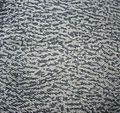
The Desert Battle Dress Uniform (DBDU) is a U.S. arid-environment camouflage battle uniform that was used by the United States Armed Forces from the early 1980s to the early to mid 1990s, most notably during the Persian Gulf War. Although the U.S. military has long since abandoned the pattern, it is still in widespread use by militaries across the world as of the early 2020s.

Flecktarn is a family of three-, four-, five- or six-color disruptive camouflage patterns, the most common being the five-color pattern, consisting of dark green, grey-green, red brown, and black over a light green or tan base depending on the manufacturer. The original German five-color pattern was designed for use in European temperate woodland terrain. A three-color variation called Tropentarn is intended for arid and desert conditions; the German Bundeswehr wore it in Afghanistan.
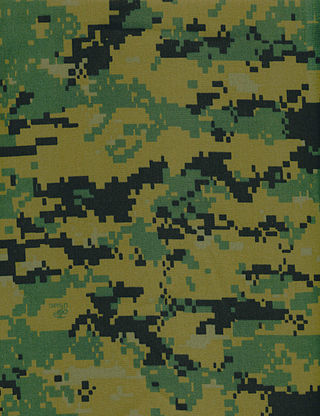
MARPAT is a multi-scale camouflage pattern in use with the United States Marine Corps, designed in 2001 and introduced from late 2002 to early 2005 with the Marine Corps Combat Utility Uniform (MCCUU), which replaced the Camouflage Utility Uniform. Its design and concept are based on the Canadian CADPAT pattern. The pattern is formed of small rectangular pixels of color. In theory, it is a far more effective camouflage than standard uniform patterns because it mimics the dappled textures and rough boundaries found in natural settings. It is also known as the "digital pattern" or "digi-cammies" because of its micropattern (pixels) rather than the old macropattern.

The Battle Dress Uniform (BDU) is a camouflaged combat uniform that was used by the United States Armed Forces as their standard combat uniform from the early 1980s to the mid-2000s. Since then, it has been replaced or supplanted in every branch of the U.S. Armed Forces.

Personnel Armor System for Ground Troops is a combat helmet and ballistic vest that was used by the United States military from the early 1980s until the mid-2000s, when the helmet and vest were succeeded by the Lightweight Helmet (LWH), Modular Integrated Communications Helmet (MICH), and Interceptor Body Armor (IBA) respectively.

Rogatywka is the Polish generic name for a peaked, four-pointed cap used by various Polish military formations throughout the ages. It is a distant relative of its 18th-century predecessor, the konfederatka, although similar caps have been used by light cavalry since the 14th century. It consists of a four-pointed top and a short peak, usually made of black or brown leather. Although rogatywka in English seems to mean the same as czapka, the word czapka in Polish designates not only rogatywka, but all caps.

Milicja Obywatelska, in English known as the Citizens' Militia and commonly abbreviated to MO, was the national police organization of the Polish People's Republic. It was established on 7 October 1944 by the Polish Committee of National Liberation, effectively replacing the pre-war police force. The Citizen's Militia would remain the predominant means of policing in Poland until 10 May 1990, when it was transformed back into Policja.
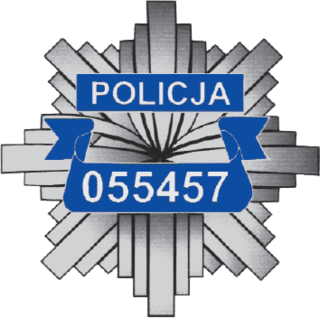
The Police is the national police force of the Republic of Poland. Its current size is 100,000 officers and ca. 25,000 civilian employees. Among the branches in the force are: Criminal Service, Traffic Police Service, Prevention Service and Supporting Service.

MultiCam is a camouflage pattern designed for use in a wide range of environments and conditions which was specifically developed and is produced by American company Crye Precision. As a result of the pattern's effectiveness across disparate environments and regions, it has found extensive adoption globally. Variants of it, some unlicensed, are in use with armed forces worldwide, particularly with special operations units.

Type 07 is a group of military uniforms used by all branches of the People's Liberation Army (PLA) of the People's Republic of China (PRC) and the paramilitary Chinese People's Armed Police Force. Introduced in 2007, the Type 07 uniforms replaced the Type 87 service uniforms used by regular units and the Type 97 Service Dress uniforms of the People's Liberation Army Hong Kong Garrison and the People's Liberation Army Macau Garrison. The Type 07 uniforms were first seen in late June 2007 during a celebration ceremony for the 10th anniversary of the Transfer of sovereignty over Hong Kong.

Law enforcement in Poland consists of the Police (Policja), City Guards, and several smaller specialised agencies. The Prokuratura Krajowa and an independent judiciary also play an important role in the maintenance of law and order.
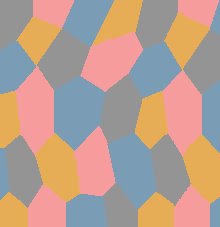
Lozenge camouflage was a military camouflage scheme in the form of patterned cloth or painted designs used by some aircraft of the Central Powers in the last two years of World War I, primarily those of the Imperial German Luftstreitkräfte. It takes its name from the repeated polygon shapes incorporated in the designs, many of which resembled lozenges. In Germany it was called Buntfarbenaufdruck but this designation includes other camouflage designs such as Splittermuster and Leibermuster, and does not include hand-painted camouflage.

The TgS-1 DUDEK was an on-line and off-line encryption system developed during the Cold War in the 1960s in the Polish People's Republic by the Telkom Teletra company and the Ministry of Interior for use on teleprinter circuits. The units saw use in the Polish Ministerstwo Spraw Wewnętrznych networks serving the, the, the Polish Ministry of National Defense, the Ministry of Foreign Affairs and the National Bank of Poland. The Poles also pressed Warsaw Pact states to adopt the DUDEK sets for international traffic.
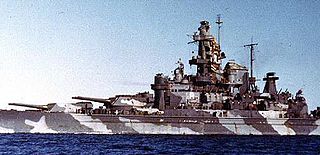
In 1935, the United States Navy Naval Research Laboratory began studies and tests on low visibility ship camouflage. Research continued through World War II to (1) reduce visibility by painting vertical surfaces to harmonize with the horizon and horizontal surfaces to blend with the sea, or (2) confuse identity and course by painting obtrusive patterns on vertical surfaces. Some camouflage methods served both purposes. American captains were permitted less freedom of interpretation with these schemes than their British Commonwealth counterparts applied to Admiralty camouflage schemes.

Strichtarn was a military camouflage pattern developed in East Germany and used from 1965 to 1990. The pattern was also used by several other militaries and non-state forces, notably in Africa.
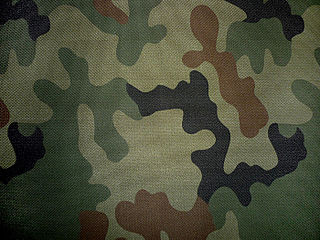
The Wz. 93 Pantera pattern has become the standard camouflage of the Polish Armed Forces. It is the successor of Camouflage wz. 89 Puma, and entered service in 1993. It differs from Puma in having stronger contrast, resulting in better disruptive camouflage.
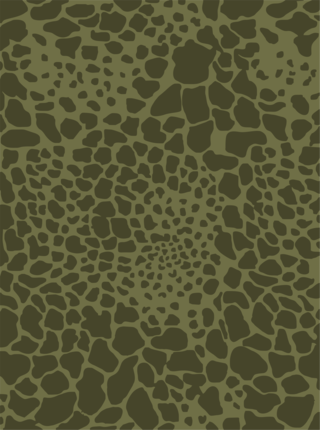
The Wz. 89 Puma was the successor of the Wz. 68 Moro pattern in the Polish Armed Forces. Puma was first produced in 1989, and was replaced in 1993 by Wz. 93 Pantera.

The Hungarian camouflage pattern 2015M, also known as HunCam, is a family of 7-color camouflage pattern. First unveiled and designed in 2015, HunCam was designed for the use of the Hungarian Defence Force in varied environments, seasons, elevations, and light conditions.
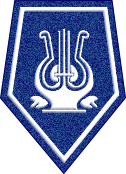
The Representative Band of the Policja is a musical unit of the Policja of the Republic of Poland. It is responsible for providing musical support and rendering honors to the President of Poland and the Minister of the Interior and Administration in the capital of Warsaw. It has been under the baton of Chief Conductor Janusz Trzepizur and Drum Major, Staff Sergeant Jakub Pietrucha. Being that it is a central band, it is the seniormost of three Polish police bands, with the other two being based in Wrocław and Katowice.




